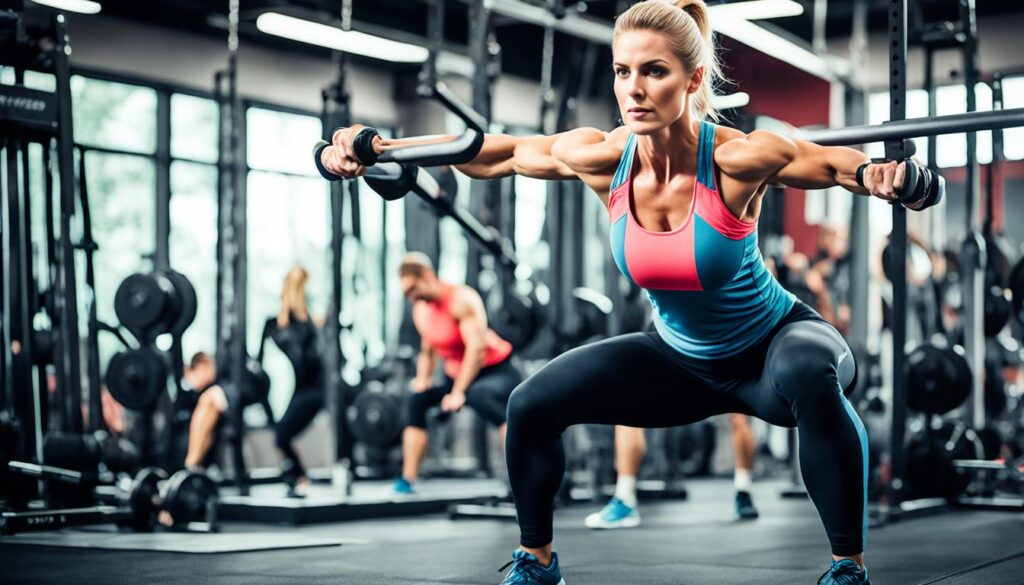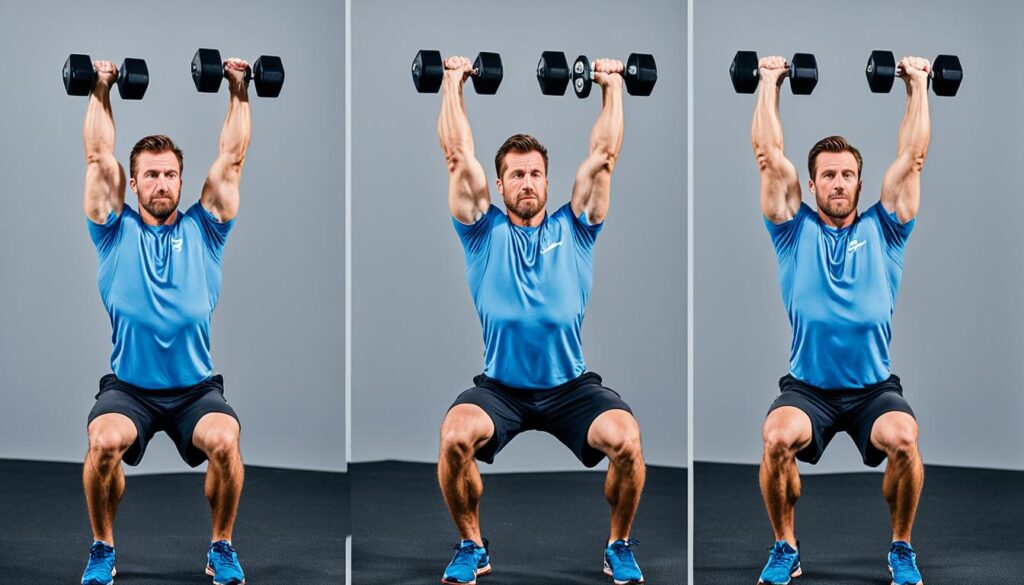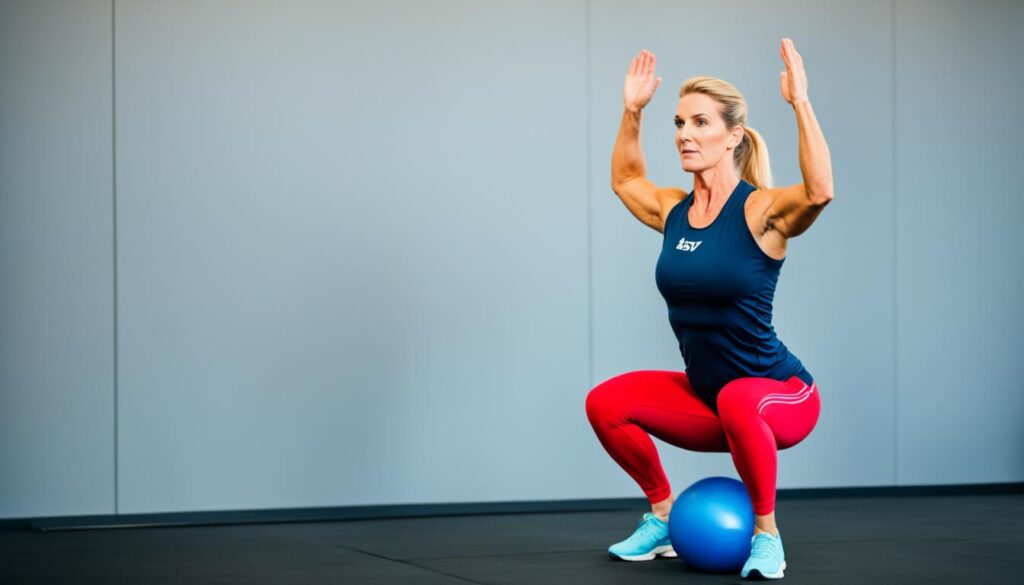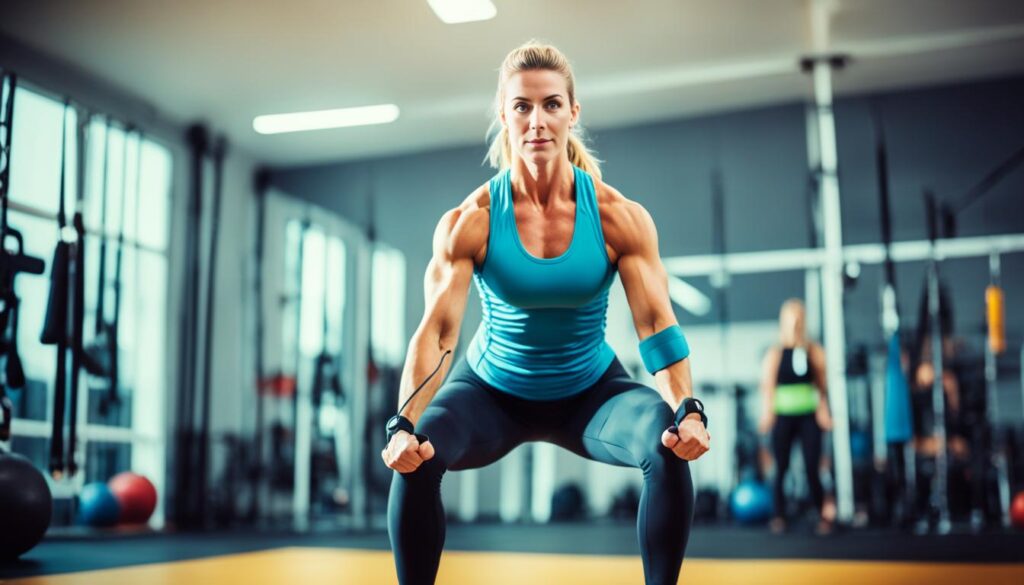Are you tired of the same old weightlifting routines that isolate individual muscle groups? It may be time to explore the benefits of functional training and how it can transform your fitness journey. Functional training focuses on whole-body movements that mimic everyday activities, helping you build practical strength and improve your overall athleticism1.
Incorporating functional training into your workout routine can offer a wide range of benefits, from reversing muscle mass decline to enhancing your coordination and mobility2. But where do you start? In this article, we’ll dive into the world of functional training and uncover the best ways to integrate it into your fitness regimen, regardless of your skill level or goals.
Key Takeaways
- Functional training focuses on compound exercises that engage multiple muscle groups and joints
- It can help reverse muscle mass decline, build and tone muscles, and improve overall fitness
- Functional movements like squatting, pushing, pulling, and rotating mimic daily activities
- Combining functional and traditional strength training can provide a balanced workout routine
- Functional training can enhance athletic performance and everyday movements
What is Functional Training?
Functional training is a type of exercise that prioritizes natural movements over exercises that are done with a machine or have little practical use3. The purpose is to get your body to move through diverse movement patterns, focusing on compound exercises that recruit multiple muscles and joints to work together3. These exercises parallel with everyday activities like squatting, sitting, standing up, walking, picking up a heavy object, or pushing open a door.
Functional training focuses on training the body for daily activities and movements, rather than isolating specific muscles3. It involves compound exercises that recruit multiple muscle groups and joints to work together, mimicking natural movement patterns like squatting, pushing, pulling, and rotating4. Functional strength training aims to improve functional movements for daily life, sports, or specific tasks, involving moves that mimic real-life movements4.
- Functional training exercises target more than one muscle or muscle group at a time, making them efficient in terms of working multiple areas simultaneously3.
- Functional training can help maintain and preserve balance, which is beneficial for older adults in preventing falls and related injuries3.
- Functional exercises prioritize muscle movement over appearance, showcasing a shift from traditional bodybuilding approaches3.
- Combine functional training with other workout styles to improve overall fitness, emphasizing the importance of diversifying exercise routines3.
- Perform intense functional movements with correct form to maximize workout benefits and reduce the risk of injury3.
- Functional training can enhance athletic performance by tailoring exercises based on the movements inherent to a specific sport3.
- Time-efficient aspect of functional exercises suggests they can be more effective for fitness and weight loss goals compared to focusing on isolated muscle groups3.
There is overlap between functional and traditional strength training4. Functional training can enhance balance, core engagement, posture, and joint stability, while dynamic stretching in functional training aids in mobility and reduces the risk of overuse injuries4. Functional strength exercises can lead to a higher caloric expenditure compared to isolated strength exercises, and individuals are advised to incorporate functional strength training two to three times a week in their workout schedules for optimal results4.
Incorporating both traditional and functional strength training can improve muscle strength and endurance4. Some examples of functional exercises include squats, deadlifts, overhead press, farmer’s walk, bear crawl, walking lunges, pull-ups, kettlebell swings, push-ups, step-ups, box jumps, and handstands5. These exercises replicate real-life movements and help develop the strength, balance, and stability required for daily activities and sports performance534.
Benefits of Functional Training
Functional training offers a wealth of benefits that can improve your overall fitness and well-being. By focusing on natural, compound movements that engage multiple muscle groups, functional training can help you develop healthier movement patterns, enhance your physique, and boost your coordination and body awareness6. It can also play a crucial role in correcting muscle imbalances, improving joint stability, and reducing the risk of injury7.
One of the primary advantages of functional training is its ability to strengthen the muscles used in daily activities. By incorporating exercises that mimic real-world movements, such as squats, pull-ups, and lunges, you can build the necessary strength, stability, and mobility to perform better in everyday tasks7. This can lead to a more toned, athletic-looking physique as multiple muscle groups are engaged simultaneously6.
Functional training has also been shown to improve overall coordination, mobility, and body awareness6. Exercises like jump squats can help reduce the risk of injury by strengthening the leg muscles and improving lower body stability6. Additionally, compound movements like the Woman Maker/Man Maker and the dumbbell thruster engage a wide range of muscles, from the quads and glutes to the shoulders and core, for a comprehensive workout6.
Push-ups, another functional exercise, target the shoulders, chest, triceps, and core, making them a valuable addition to any fitness routine6. By incorporating a variety of functional exercises into your workouts, you can develop a stronger, more resilient body that is better equipped to handle the demands of daily life and physical activity7.
“Functional fitness can reduce the risk of injury and increase the quality of life by strengthening muscles geared towards daily tasks.”7
Ultimately, the benefits of functional training extend far beyond the gym, helping you move with greater ease, confidence, and resilience in your everyday life8.
Incorporating Pull-ups
Pull-ups are a fundamental functional exercise that target multiple muscle groups simultaneously, including the back, arms, shoulders, core, and glutes9. Incorporating pull-ups into your workout routine can help improve posture, increase upper body strength, and enhance overall functional fitness9. However, quality trumps quantity when it comes to pull-ups, and focusing on proper form is crucial for maximizing the benefits and avoiding injury9.
Mastering the pull-up technique can be challenging, but there are resources available to help. Programs like The Ultimate 12-Week Pull-Up Program can aid in learning the fundamentals and progressively building the strength and endurance needed to perform pull-ups with proper form9. Consistency is also highlighted as a key factor in achieving success with pull-ups and reaching your fitness goals9.
Pull-ups target a variety of muscle groups, including the back, arms, shoulders, and core, making them an effective exercise for building overall upper body and functional strength10. Using an overhand grip during pull-ups can also enhance grip strength, which is beneficial for athletic performance and overall health10. Additionally, pull-ups can be effective in building muscle mass, reversing age-related muscle loss, and contributing to changes in body composition by aiding in fat burning and improving insulin sensitivity10.
Strengthening the back and core muscles through pull-ups can lead to improved posture, injury prevention, and increased confidence10. Furthermore, pull-ups can enhance athletic performance, particularly in sports involving pulling or gripping activities like lifting and rowing10.
Pull-ups engage multiple muscle groups, including the back, shoulders, and arms, making them an effective exercise for improving upper body strength11. They also help build endurance, increase overall muscle mass, and promote functional strength11. Pull-ups contribute significantly to enhancing grip strength, which is crucial for various fitness activities and exercises11.
Pull-ups can be performed in various locations, such as the gym, park, or home, making them accessible to fitness enthusiasts11. Doorway pull-up bars, ceiling-mounted bars, and wall-mounted bars offer versatility in installation and exercise diversity, while pull-up racks provide a stable framework for performing pull-ups and enable a wide range of exercises11. Factors to consider when choosing a pull-up bar include available space, budget constraints, weight limitations, and grip options11.
“Consistency is the key to mastering pull-ups and achieving your fitness goals.”
Woman Maker/Man Maker
The Woman Maker or Man Maker is a challenging functional training exercise that combines multiple compound movements into a single, dynamic sequence. This full-body exercise targets a variety of muscle groups, including the arms, shoulders, core, and legs, making it an effective addition to any fitness routine12.
To perform the Woman Maker/Man Maker, you’ll start in a push-up position, then row one dumbbell to your chest, followed by a clean and press with that dumbbell. Next, you’ll perform a burpee, stepping your feet back into a plank, then jumping your feet back to your hands before standing up and repeating the sequence on the other side12.
This exercise requires coordination, strength, and endurance, making it a challenging but rewarding addition to your functional training regimen. Beginners may want to start with lighter weights and focus on proper form before gradually increasing the intensity12.
The Woman Maker/Man Maker is a prime example of how functional training can enhance overall fitness and performance. By incorporating compound movements that mimic real-world activities, this exercise helps improve muscle coordination, balance, and power – all while providing a comprehensive full-body workout12.
| Exercise | Reps | Sets | Rest |
|---|---|---|---|
| Woman Maker/Man Maker | 8–12 | 3-4 | 60-90 seconds |
Incorporate the Woman Maker/Man Maker into your workout routine 1-2 times per week for optimal results. Remember to start with a lighter weight and focus on proper form before gradually increasing the intensity as you build strength and endurance13.

“Functional training exercises like the Woman Maker/Man Maker are invaluable for building the kind of practical strength and coordination needed for everyday life and athletic endeavors.”
Sled Pull/Push
Sled pulls and pushes are joint-friendly exercises that improve conditioning and work multiple muscle groups simultaneously14. These functional training movements are adaptable to various fitness levels and can be tailored to target specific goals, such as speed, power, or endurance14.
Sled Pulls and Pushes: Versatile Functional Training
To perform a sled pull or push, simply load the sled with your desired weight and either pull or push it for a certain distance. This compound exercise engages the glutes, quads, hamstrings, calves, middle back, lats, chest, shoulders, triceps, and biceps, providing a full-body conditioning workout1415.
For speed development, the sled weight should allow for good speed without excessive resistance to enhance stride frequency and muscle engagement15. Conversely, power development calls for heavier loading to recruit maximum motor units and boost force output15. Sled pulls, in particular, are noted for recruiting numerous motor units in the hips, hamstrings, and quads, emphasizing overload on the posterior chain15.
| Exercise | Load Percentage | Training Focus |
|---|---|---|
| Sled Push | Slightly less than max | Strength |
| Sled Push | Max weight for longer durations | Muscle Building |
| Sled Push | Allow near-normal running speed | Speed Improvement |
| Sled Pull | 50-60% of max | Speed Development |
| Sled Pull | Heavy loading | Power Development |
The sled push is considered as effective for building leg muscle and strength as the deadlift and squat, yet it places less strain on the body16. Incorporating sled pushes and pulls into a fitness routine can benefit both strength and endurance athletes, helping to increase leg strength, speed, and muscle growth without conflicting with primary strength-building movements16.
It’s important to maintain proper form when performing sled exercises, including a natural running stance, neutral spine, and core bracing14. Seeking guidance from a fitness professional is recommended, especially for beginners or those experiencing any discomfort or pain during the exercises14.
One Arm Kettle Bell Snatch
The one-arm kettle bell snatch is a dynamic, full-body exercise that challenges your strength, power, and coordination. This movement requires synchronizing the hip hinge, shoulder stability, and explosive hip extension to efficiently lift the kettle bell overhead17.
To master the one-arm snatch, it’s important to first learn proper kettle bell technique through exercises like traditional kettle bell swings and goblet squats17. Hiring a coach with certified kettle bell training can also help you develop good habits and avoid potential injury17.
When performing the one-arm snatch, focus on engaging your core, glutes, and quads intensively to generate more functional strength17. Tensing these major muscle groups can make your central nervous system feel more secure, allowing you to produce greater power17. However, it takes practice to coordinate the simultaneous contraction of these muscle groups17.
Consider using a hand towel or water bottle to better grip the kettle bell during the lift, as this can help improve your hand and forearm strength17. Suggested programming for the one-arm snatch could include sets of 5 reps per side, gradually increasing the number of reps for conditioning17.
To further challenge yourself, try performing the one-arm snatch with a bottom-up grip. This grip variation engages your core and shoulder stabilizers to a greater degree, strengthening these critical muscle groups17.
Incorporating the one-arm kettle bell snatch into your workout routine can help improve your full-body strength, power, and cardiovascular fitness18. With proper technique and progressive overload, this exercise can be a valuable addition to your functional training regimen.
| Exercise | Sets x Reps |
|---|---|
| One-Arm Kettlebell Swing | 5 x 10 + 10 |
| One-Arm Front Squat | 3 x 5 + 5 or 5 x 2 + 2 |
| One-Arm Press | 5 x 3 + 3 or varied sets like 2 + 2, 3 + 3, 5 + 5, 3 + 3, 2 + 2 |
| One-Arm Snatch | 5 x 5 + 5 or increase reps like 6 + 6, 7 + 7, etc. for conditioning |
Remember, consistent practice and attention to proper form are key to maximizing the benefits of the one-arm kettle bell snatch19. Incorporating this dynamic exercise into your routine, along with other functional training movements, can help you achieve your fitness goals and improve your overall strength and performance.
Jump Squat
Jump squats are a dynamic exercise that can significantly enhance your lower body strength, power, and explosiveness20. This functional training movement targets the leg muscles, including the quadriceps, hamstrings, and glutes, while also improving overall lower body stability20. Jump squats are known for their ability to reduce the risk of injury by building strength and stability in the lower body20.
As a beginner, it’s recommended to start with single jump squats, as they are considered less complex compared to more advanced variations20. However, as you progress in your training, incorporating multiple jump squat variations can provide an even greater challenge and further enhance your power and explosiveness20.
When performing jump squats, it’s important to maintain proper form and technique. The load should be relatively light, around 20-30% of your one-rep maximum20, and it’s suggested to incorporate 2-3 sets of 3-5 reps into your training routine20. This exercise can help program your movement patterns to stay vertical, which is crucial for weightlifting and vertical jumping20.
Jump squats can be beneficial for athletes of all levels, from beginners to advanced21. They can help weightlifters improve the explosive power necessary for movements like snatches and clean & jerks21, and can also add variety, power variables, and dynamic movements to bodybuilding routines21. Beginners are recommended to start with three sets of jump squats, focusing on perfecting their form and developing maximal power21.
When incorporating jump squats into your workout routine, it’s important to pay attention to overlap and overtraining, and adjust other leg exercises as needed to avoid hindering your progress21. Jump squats can also be used as a warm-up or recovery exercise, as they engage the nervous system without inducing heavy muscular fatigue22.
“Jump squats are a highly effective functional training exercise that can enhance your strength, power, endurance, and explosiveness.”
In conclusion, jump squats are a dynamic and versatile exercise that can benefit athletes of all levels. By incorporating this movement into your training routine, you can improve your lower body strength, power, and overall athletic performance202122.
Dumbbell Thruster
The dumbbell thruster is a comprehensive functional training exercise that engages multiple muscle groups simultaneously. By combining a front squat and an overhead press, this dynamic movement targets the calves, quads, adductors, glutes, hamstrings, core, upper back, chest, deltoids, and triceps23. Incorporating the dumbbell thruster into your workout routine can be an efficient way to burn more calories and promote fat loss, as it involves both lower and upper body movements that increase cardiovascular activity23.
One of the key benefits of the dumbbell thruster is its ability to enhance strength and power. By using heavier weights, you can build triceps and shoulder strength23, while the core engagement through the upper back and anterior core can also improve overall core strength23. However, it’s important to maintain proper form to avoid common mistakes, such as dropping the elbows or lacking coordination between the legs and arms, as these can hinder the effectiveness of the movement23.
Variations of the thruster, such as the single-arm kettlebell thruster or the dumbbell thruster, offer alternative options for those who may struggle with the barbell clean position or have imbalances between sides23. These modifications can help address individual strengths and weaknesses, ultimately leading to a more well-rounded and functional fitness routine.

When performing the dumbbell thruster, it’s crucial to avoid hyperextending the lower back, as this can lead to strain. Instead, focus on squeezing the glutes at the lockout position to maintain proper alignment23. By mastering the technique and progressively increasing the weight, you can maximize the benefits of this compound exercise and take your fitness to new heights.
Remember, the dumbbell thruster is a versatile and effective functional training exercise that can be seamlessly integrated into your workout routine. By incorporating it, you’ll unlock the potential for improved strength, power, and overall physical well-being23.
Push up
Push-ups are a time-honored and highly effective compound exercise that targets multiple upper body muscle groups, including the shoulders, chest, triceps, and core24. This classic exercise not only builds impressive upper body strength but also enhances the muscles used in everyday activities like pushing and lifting, making it a valuable addition to any functional training routine.
Beginners can start with modifications like placing hands on a bench or an elevated surface slightly wider than shoulder-width apart to ease into the exercise24. Another beginner modification involves starting in a plank position on palms and lowering knees gently to the floor before executing the push-up motion24. As you progress, you can explore intermediate variations such as traditional push-ups with hands placed wider than shoulder-width apart to primarily engage the chest24, or triceps push-ups where elbows remain close to the body while lowering the chest towards the ground24.
For those seeking a greater challenge, advanced push-up variations, such as explosive plyometric push-ups, can improve upper body power and speed24. Adding resistance, like a weight plate or a weighted vest, can also challenge the chest, shoulders, and triceps to a higher degree24. Incorporating movement variations, like rotating the body to the side between each push-up repetition, can further engage the chest, shoulders, and core muscles24.
The push-up is a versatile exercise that has stood the test of time, dating back thousands of years25. Variations of push-ups, including wide push-ups, incline push-ups, pike push-ups, scapular push-ups, plyometric push-ups, and knee push-ups, offer a range of benefits, such as targeting multiple muscle groups, increasing upper body strength, and improving posture25.
While push-ups are generally regarded as a safe and effective exercise, it’s crucial to maintain proper form to avoid injuries25. Incorrect push-up technique can lead to pain and issues in the joints, particularly the shoulders and elbows25. As an alternative, the FP Contralateral Step Press offers similar benefits while prioritizing human biology and promoting pain-free movement25.
Functional training, which focuses on exercises that mimic everyday movements, can be an excellent complement to push-ups. Functional training not only enhances upper body strength but also improves overall flexibility, mobility, and muscle coordination26. Incorporating push-ups and other functional exercises into your workout routine can lead to improved performance in daily activities and a reduced risk of injury26.
| Push-Up Variations | Benefits |
|---|---|
| Beginner Modifications | Easier entry point, engage upper body muscles |
| Intermediate Variations | Targeted chest, triceps, and shoulder engagement |
| Advanced Variations | Improved upper body power, strength, and endurance |
By incorporating a variety of push-up variations into your functional training routine, you can build impressive upper body strength, enhance your performance in daily activities, and reduce the risk of injury. Remember to focus on proper form and consider alternative exercises like the FP Contralateral Step Press to prioritize your body’s unique needs and promote long-term, pain-free fitness.
“Functional training is essential for improving everyday movements, flexibility, and overall muscle strength.”
How to incorporate functional training into my workout routine?
Functional training is a holistic approach to fitness that aims to prepare and train the body for the demands of daily life movements27. By focusing on compound exercises that engage multiple muscle groups and joints, functional training can help make everyday tasks easier and safer to perform27. This style of training emphasizes core activation, promoting improved stability, balance, and overall functional fitness27.
Incorporating functional training into your workout routine can provide numerous benefits, including reduced injury risk27, increased calorie burn due to engaging multiple muscle groups simultaneously27, and enhanced muscle symmetry and balance27. Functional exercises can be performed with minimal equipment, utilizing bodyweight as resistance, making them accessible and convenient27.
- Start with the Basics: Incorporate fundamental functional exercises like squats, deadlifts, push-ups, and pull-ups into your routine28. These compound movements target multiple muscle groups and mimic real-life movement patterns.
- Vary Your Exercises: Experiment with different variations of these basic movements, such as front squats, Bulgarian split squats, and one-arm push-ups, to challenge your body in new ways28.
- Focus on Core Strength: Exercises like planks and other core-centric movements are crucial for functional training, as they enhance stability and balance, which are essential for daily activities27.
- Incorporate Explosive Movements: Incorporate exercises like box jumps and explosive push-ups to develop power and improve athletic performance28.
- Prioritize Mobility and Flexibility: Ensure that your functional training routine includes mobility and flexibility work to maintain optimal range of motion and joint health28.
Functional fitness has gained considerable traction in recent years, highlighting the importance of practical physical prowess alongside aesthetics in fitness routines29. By incorporating functional training into your workout, you can enhance your overall physical preparedness, efficiency in everyday tasks, and reduce the risk of injuries29.

Remember, the key to successful functional training is to focus on movements that mimic real-life activities, engaging multiple muscle groups simultaneously for a more holistic approach to fitness29. With patience and consistency, you can develop a well-rounded level of physical preparedness that will benefit you in both your daily life and athletic pursuits29.
Functional Training for Athletic Performance
Functional training has emerged as a powerful approach to enhance athletic performance across various sports. By focusing on exercises that mimic natural movement patterns, functional training aims to improve overall fitness, strength, and agility – attributes crucial for success in competitive athletics.
According to research, athletes who perform functional strength training see improvements in speed, muscular strength, power, stability, and agility30. Functional training exercises target multiple muscles and joints simultaneously, helping runners and other athletes enhance their daily activities and movements30. Dynamic stretching has also been proven to enhance running performance, as noted by the National Strength and Conditioning Association (NSCA)30.
Experts typically recommend engaging in strength training two to three times a week to reap the benefits of functional training30. Some of the most effective functional strength exercises for runners include quad stretches, hip openers, hamstring scoops, deep squats, walking lunges, Bulgarian split squats, and single-leg hops30.
Functional fitness exercises are essential in training muscles to work together, simulating common movements for daily tasks and sports31. These exercises are noted for increasing core stability, emphasizing mobility, and providing injury prevention, particularly for joints prone to injury such as knees, shoulders, and backs31.
Incorporating functional training into workout routines can benefit athletes across different disciplines, including throwers, runners, lifters, and various sports and recreational athletes31. Functional fitness is highlighted as crucial for in-season athletes, aiding in injury prevention, enhancing recovery, and emphasizing core strength, balance, and movement integrity31.
| Exercise | Benefits |
|---|---|
| Z Presses | Enhance shoulder mobility and stability |
| Weighted Holds and Carries | Improve grip strength and core stability |
| Cossack Squats | Improve hip and ankle mobility |
| Nordic Hamstring Curls | Increase eccentric strength, reduce hamstring strains, and improve explosive movements |
| Turkish Get-Ups | Enhance hip mobility, core stabilization, and shoulder mobility and stability |
A recent systematic review examined the effects of functional training on various aspects of physical fitness in athletes32. The review found that functional training significantly impacted speed, muscular strength, power, balance, and agility in athletes, while there was limited evidence showing its effect on flexibility and muscular endurance32. Interestingly, no significant improvement was found in body composition through functional training interventions32.
In conclusion, functional training offers a holistic approach to enhancing athletic performance, focusing on improving overall fitness, strength, and agility. By incorporating a variety of functional exercises into their training regimen, athletes can optimize their physical capabilities and gain a competitive edge in their respective sports.
Combining Functional and Traditional Strength Training
Functional training and traditional strength training each have their own distinct advantages, and integrating the two can provide a well-rounded and balanced workout routine. While functional training focuses on compound movements that mimic natural body motions, traditional strength training targets specific muscle groups through isolated exercises33.
By combining these two training styles, individuals can enjoy the benefits of both approaches, leading to improved overall fitness and practical strength34. Traditional strength training typically consists of four to six different exercises, repeated eight to 12 times each, with sets repeated three to five times33. On the other hand, functional strength training involves dynamic, full-body, multiplane movements designed to engage multiple muscle groups simultaneously33.
Incorporating functional training into a workout routine can enhance mobility, stability, endurance, and mindfulness33. People engaging in functional strength training can customize their routines based on their exercise level and goals, and perform workouts anywhere, such as a hotel room or living room33. However, the primary drawback of functional training is the higher chance of performing exercises incorrectly, which can lead to not receiving the full benefits or causing injury33.
To address this, individuals can combine functional and traditional strength training exercises to create a balanced workout that leverages the strengths of both approaches. Functional training can improve overall fitness and practical strength, while traditional strength training can target specific muscle groups and provide a more structured approach34. The integration of these two training styles can lead to enhanced muscle development, bone health, and basal metabolic rate, as well as improved balance, coordination, and overall physical fitness35.
Ultimately, by combining functional and traditional strength training, individuals can create a versatile and effective workout routine that addresses their specific fitness goals and needs, whether they are focused on improving athletic performance, enhancing daily functionality, or simply maintaining a healthy and balanced lifestyle. Hybrid workouts that incorporate both approaches can be particularly beneficial, as they leverage the strengths of each method to deliver comprehensive and customizable training programs35.
“Functional strength training can promote mindfulness by requiring individuals to focus on their body movements, which can help improve form, prevent injury, and boost mood and self-confidence.”33
| Metric | Traditional Strength Training | Functional Strength Training |
|---|---|---|
| Muscle Development | 35% of individuals benefit | Improved through compound exercises |
| Bone Health | 35% improvement | Increased through weight-bearing exercises |
| Basal Metabolic Rate | 35% increase | Elevated through full-body movements |
| Workout Frequency | 35 sessions per week | Versatile and accessible |
| Muscle Engagement | Isolated exercises | 35% more effective |
| Balance and Coordination | Limited improvement | 35% increase |
| Injury Prevention | 35% with proper form | 35% with proper form |
Conclusion
In conclusion, incorporating functional training into your workout routine can be a game-changer, providing a comprehensive approach to improving overall fitness and physical performance. By focusing on multi-joint exercises that mimic natural movement patterns, functional training engages multiple muscle groups simultaneously, leading to significant enhancements in strength, power, and sport-specific abilities363738.
The benefits of functional training extend beyond just physical improvements, as it can also enhance joint health, reduce the risk of injury, and promote better body awareness and coordination38. Additionally, the versatility of functional training allows it to be tailored to individuals of all ages and fitness levels, making it an accessible and effective strategy for those seeking to improve their overall functional capacity38.
By combining functional training with traditional strength-building exercises, you can create a well-rounded fitness regimen that addresses both specific muscle groups and holistic movement patterns. This balanced approach, coupled with proper nutrition, supplementation, and gradual progression, can lead to significant improvements in your overall health, fitness, and athletic performance363738.
FAQ
What is functional training?
Functional training is a type of exercise that focuses on training the body for daily activities and movements, rather than isolating specific muscles. It involves compound exercises that recruit multiple muscle groups and joints to work together, mimicking natural movement patterns like squatting, pushing, pulling, and rotating.
What are the benefits of functional training?
Functional training offers several benefits, including healthier movement patterns, improved physique, enhanced coordination, body awareness, and mobility. It can also help correct muscle imbalances, improve joint stability, and reduce the risk of injury.
How can I incorporate sled pulls and pushes into my functional training routine?
Sled pulls and pushes are joint-friendly exercises that improve conditioning and work multiple muscle groups simultaneously. Load the sled with your desired weight and either push or pull it for a certain distance.
What are the benefits of incorporating jump squats into my functional training?
Jump squats are dynamic exercises that enhance strength, power, endurance, and explosiveness. They strengthen the leg muscles, improve lower body stability, and reduce the risk of injury.
How can push-ups improve my functional training routine?
Push-ups are a compound exercise that engages multiple upper body muscle groups, including the shoulders, chest, triceps, and core. They strengthen muscles used in daily activities like pushing and lifting.
How can I combine functional and traditional strength training effectively?
While functional training focuses on compound movements, traditional strength training targets specific muscle groups. Combining both styles can provide a balanced workout routine, improving overall fitness and practical strength.
Source Links
- How to Maintain Your Functional Strength While Sheltering in Place
- Functional Fitness: Training for Daily Movement
- How to Exercise With Functional Training
- 7 Functional Strength Training Moves That Peloton Instructors Swear By
- What is Functional Fitness? (11 Exercises) | Nerd Fitness
- Incorporating Functional Training into Your Exercise Routine
- Why Functional Fitness Is Important
- Functional training: What is it and what are the benefits?
- Your Ultimate Guide to Incorporating Pull-Ups into Your Everyday Workout Routine
- 7 Reasons to Add Pull Ups to Your Workout – GoodRx
- Comprehensive Analysis of Pull-up Training: Choosing and Using Bars and Racks | NutroOne
- Discover the top 10 exercises for a full body workout
- 30-Minute Dumbbell Arm Workout (Video) | Nourish Move Love
- Sled Push: How to Use It to Build Power, Speed, & Endurance
- 8 Ways to Incorporate the Sled into Your Workout
- The Sled Push May Be the Ultimate Leg-Builder (Yes, We’re Serious) | BarBend
- Functional Strength Training: 8 One-Arm Kettlebell Exercises
- Kettlebell Training for Strength
- Best way to combine KBs with other strength/weight training
- The Jump Squat: How, When, and Why Weightlifters Should Include Them In Training | BarBend
- Take Your Leg Training to New Heights With the Jump Squat | BarBend
- The 30 Best Exercises for Functional Strength and Mobility
- How To Do a Thrusters Workout | Garage Gym Reviews
- 15 Push-Up Variations to Master at Every Level of Your Fitness Journey
- RETHINKING PUSH UP WORKOUTS
- Cooper Aerobics
- Functional Training: How to Turn Your Daily Routine Into a Workout Session
- Functional Strength Training Benefits for True Strength | GymBird
- How Do I Incorporate Functional Fitness Into My Existing Workout Routine?
- For Runners, Functional Strength Training Can Help Overall Performance
- 6 Functional Movements Every Athlete Should Master | TrainHeroic
- Effect of Functional Training on Physical Fitness Among Athletes: A Systematic Review
- Functional Strength Training: Tips and Exercises
- Functional Training for Improved Fitness Performance
- Traditional vs. Functional Strength Training – What’s the Difference?
- Functional Training: Preparing Muscles for Daily Activities Through Ta
- The Gym Revolution
- The Key Benefits of Functional Strength Training!


